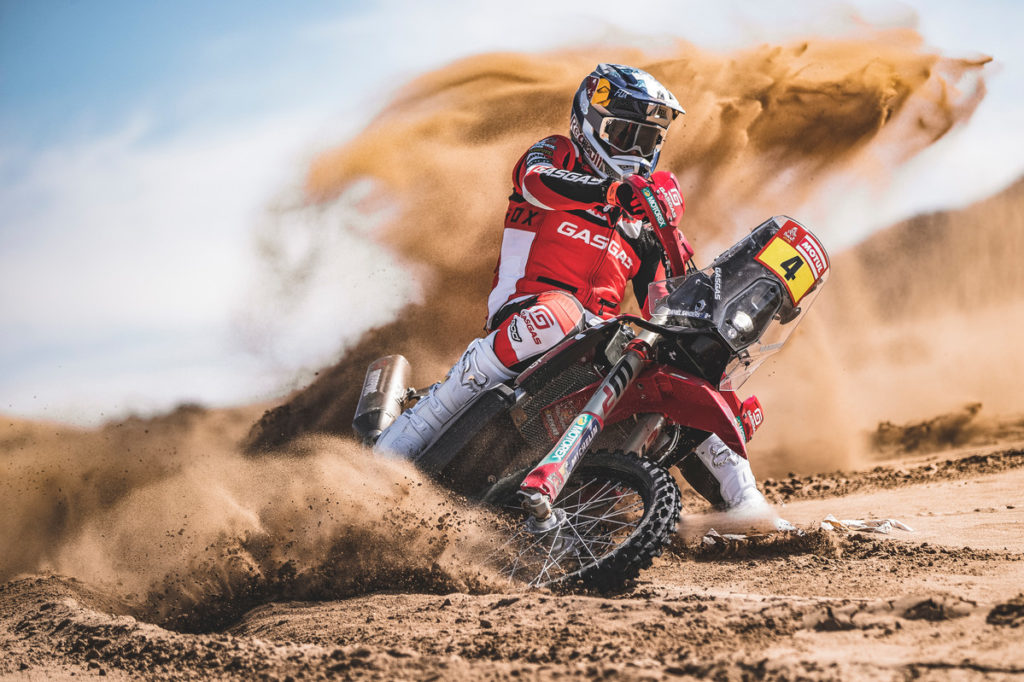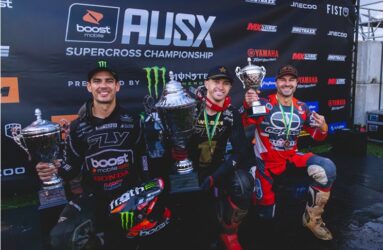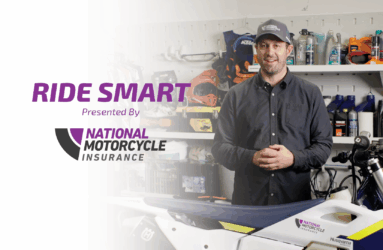DANIEL SANDERS: DAKAR REFLECTIONS
After his impressive Dakar Rally debut and standout performance in the 2021 FIM Cross Country Rallies World Championship, Australia’s Daniel Sanders quickly established himself as a damn quick learner and the sport’s hottest new property. And despite his inexperience – and the incredible depth of riding talent in rally raid these days – the 27-year-old GASGAS Factory Racing rider went into January’s 2022 Dakar Rally as a genuine contender for the win.

Sadly, after getting off to a bloody good start in the 2022 Dakar and reinforcing expectations that he could run with the best of them, Sanders’ event came to an abrupt halt when he went down hard on a tarmac transport section and banged himself up pretty badly.
So, with the benefit of hindsight – and the time that recuperating from a few operations enforces on a rider – how does Sanders reflect on his 2022 Dakar Rally experience? And where does he plan to take things from here?


TM: Back in Feb, when you had the operation on your elbow – mainly to fix what hadn’t been done properly over in Saudi – you at least knew you were in a safe set of hands with Doctor Stephen Andrews up in Brisbane, right?
DS: Yeah, mate. He’s got a lot of successful runs on the board with professional athletes and does amazing work. He fixed up Grabbo [Ben Grabham] after he hit a kangaroo and banged himself up at that Yellow Mountain race all those years ago, and then his wrist after Finke. Plus, he’s does a bunch of operations on Toby [Price]. He’s one of the best in the business for sure. And I’ll be going back to him any time I have an upper limb injury that needs fixing.
“The airbag jacket no doubt helped prevent the injuries from being a lot worse too, plus it recorded some pretty big G-force numbers when I slammed the curb.”
But the wrist and elbow weren’t the only injuries from that weird Dakar crash, were they?
Well, the elbow was the worst injury. But I also got a few internal hematomas, a lacerated kidney and a few cracked ribs. Plus, I needed another shoulder reconstruction a couple of months afterwards to fix an ongoing issue I’d had with it dislocating – which actually happened a couple of times during the Dakar; before I had the Day 7 crash that put me out. When you look at the height of that curbing I hit, and the speed I hit it at, I was lucky. I didn’t even get a concussion. The airbag jacket no doubt helped prevent the injuries from being a lot worse too, plus it recorded some pretty big G-force numbers when I slammed the curb and then rolled a few more times. When I came to a stop, I was badly winded and my whole insides had been squashed and felt like jelly. I knew that was the end of my Dakar Rally. It was 4am and a crash on the freeway – a freeway with crap lighting and really badly marked lines – had put me out of my first Dakar!

There were also a lot of positives you could take out of the event, though. Aside from the fact you and your teammate, Sam Sunderland, were rocking the best-looking riding gear in the bivouac, you got two stage wins and had all the frontrunners looking over the shoulders.
I know [laughs]. How good was our Fox gear! But you’re right. I was really satisfied with my pace and how comfortably I was on the bike. The only other time in my career that I’ve been that comfortable with my bike was at the 2019 Six-Day in Portugal, when I won Outright. I had that much confidence in both my riding and the bike, it was crazy.
“I knew that my best chance to do well at Dakar was to ride the bike I felt comfortable on and focus all my energies on navigation in those final three months leading into the Dakar.”

Tell us a bike more about that. How much did getting your set-up that on-point have to do with the help that Ben Grabham and Choice Suspension’s Anthony Giles gave you before the race?
Grabbo and Gilesy came over the Saudi for some pre-Dakar testing in early December last year, and that really helped me get that last 10 percent of performance. In October, the team asked me what I thought I needed to win Dakar, and I said that I needed to do some testing with two Aussie guys I know and trust. Grabbo and Gilsey know how I set my bike up so much stiffer than everyone else and how I make that work with my riding style. Gilsey’s settings felt great straight away. I could have my weight anywhere on the bike and still be confident that the rear wheel would stay in contact with the ground and not kick me around. And when you’ve got that sort of confidence in the bike’s handling, it frees you up to focus on navigation.

It was interesting that GASGAS wasn’t trying to hide the fact that you raced the ‘old’ bike with the trellis frame, rather than the new bike with the perimeter frame.
Yeah, well, the team of course wanted me to run the new bike – the same as what my teammate, Sam Sunderland, was racing. But I’d made the call back in October, after the rally in Morocco, that I didn’t want to be doing any more testing on the new bike. I knew that my best chance to do well at Dakar was to ride the bike I felt comfortable on and focus all my energies on navigation in those final three months leading into the Dakar. I learned that lesson in 2016, when I won the AORC on KTM’s 2016 300EXC and then jumped on the all-new 2017 300EXC a month later for the ISDE. Not having the new bike dialled and not feeling completely comfortable on it cost me the ISDE Outright win that year. You saw the same thing with the guys on the new-generation KTMs in this year’s AMA Supercross.

Letting you ride the old bike at Dakar can’t have been an easy call for your GASGAS team to make. Not the sort of thing the marketing department takes kindly to, right?
Right! Which is why they initially pushed me pretty hard to join Sam on the new bike. But I felt that strongly about it, I called the bosses in Austria and argued my case. I pretty much said, ‘Let me have this and I’ll go and win Dakar’.

From a performance point of view, what are the biggest differences between the old and new machines?
Ummm, I need to be careful here and not get myself in the shit like I always do [laughs]. I rode the new bike a few times and did the pre-Dakar photo shoot on it. Its ergos are amazing. The new frame takes a lot of the vibration away, which is a big thing for long races. My take was that it’s got so much potential, but we ran out of time to get it dialled before Dakar. With that new frame, shock and swingarm set-up, I just couldn’t get the same high-speed stability out of it. It was such a big change and I just couldn’t gel with it in the timeframe we had. I’m sure that, with another month or two, I would have worked out how to get comfortable on it. But we just didn’t have that time before Dakar. Sam only made the decision about riding the new bike at Dakar after our last week of testing, when all our bikes and gear had to get shipped to Saudi.
“Taking a stage win at Dakar has always been a huge thing. So giving one up – y’know, losing the battle to win the war – is a bit of a strange thing.”
At the last two Dakars, there’s been a pattern of really erratic results from one day to the next. In other words, winning a stage puts you at a huge disadvantage the following day, when you need to lead out. Is that why you ‘took a picnic’ and gave up the lead on Stage 3 this year?
You’re right. There’s a big yo-yo effect these days – especially in the first week, before you get people dropping out. Yeah, that’s why I gave up the Stage 3 win. You have to look at the bigger picture. If I’d gone on to win that stage and led out of the following day’s super-long stage with difficult navigation, I probably would have lost 10 minutes, maybe more. Ideally, I would have started about 10th for Stage 4, but because I only waited three minutes the previous day, not eight, I started way too close to the front guys and that cost me.




“When I got into rocky sections, my suspension was working so well, and knew I could be 20 or 30 percent faster than everyone else.”
Having to play that strategy game just feels wrong. Shouldn’t the Dakar reward each and every stage win, rather than create disincentives to win a stage?
Taking a stage win at Dakar has always been a huge thing. So giving one up – y’know, losing the battle to win the war – is a bit of a strange thing. But it’s the nature of the race. You have to think of the overall. For a guy like me who just wants to go fast all the time, it’s really annoying. Being told to slow down feels like fighting someone, but not being able to punch them [laughs]. Being so competitive, I hate that strategy at Dakar. But with the race now having 20 really fast riders on good equipment, it’s a simple fact that you have to be strategic to win the Dakar Rally. That said, I don’t like the idea that guys can hover around that fourth to seventh position all the time – not being fast enough, and never looking like they’re going go anywhere near wining a stage – and yet finish right up there in the Overall standings.
“I finally snapped. I told them it wasn’t my fault that they hadn’t set their bikes up for this sort of terrain and that they were all f#@ken pussies.”


Tell us about that shortened Stage 6, when you had a crack at the other riders for complaining that conditions were too dangerous. You copped a bit of blowback there, I hear.
Everyone knew what that stage was going to be rough and dangerous because there were deep tracks left by the cars and trucks. A similar thing had happened at the Morocco Rally, with many riders saying the rocky terrain was too dangerous. I mean, the sport is all about reading the terrain. Anyway, not far into that stage, a few front-running guys had crashed as there were deep truck ruts with a rock shelf at the bottom of them. So when we got to the first refuel, riders started saying it was too dangerous. But after that, everyone figured out that they needed to get off the main line. I mean, it’s not like you’re stuck between trees on a firetrail; it’s an open canvass out there and you can make your own line. I was comfortable in that section and had caught a heap of guys because I knew what it was going to be like and set up my bike up to suit that. And when I got into rocky sections, my suspension was working so well, and knew I could be 20 or 30 percent faster than everyone else. So at the next fuel stop, other riders were asking me if I thought it was too dangerous, and I was, ‘Nah, I’m loving it. It’s fine’. But they wouldn’t have a bar of it. They were all saying that they had families back at home and that the stage need to be cancelled. Because I didn’t agree and fall in line with them, a few guys started going off at me. And after they kept going off at me, I finally snapped. I told them it wasn’t my fault that they hadn’t set their bikes up for this sort of terrain and that they were all f#@ken pussies. At that point, I was just thinking about how I’d been away from home for eight months and sacrificed so much to be there at Dakar. So I just told them what I felt, which is that I wanted to keep racing the stage.

Organisers did end up cancelling that stage, right?
Yeah, they did; from kilometer 102. But they said they did it for some other reasons; for safety reasons because the cars were on another loop than us … or something like that. Whatever the case, I got shafted. I could have made up heaps of time on that stage, but I only made up bugger-all.
So at that point, you were sitting in third overall, just four minutes behind the lead. Well within striking distance, but then you slammed that curb at Mach 1 at 4am the next morning.
Yep. Well, there was a rest day in between, I think, but that was all she wrote for my 2022 Dakar Rally.
Which meant your start to the FIM World Rally Raid Championship wasn’t what you’d hoped for, either.
Exactly. Dakar is double points for that new Championship too. In any case, I’m going to miss the series’ first three rounds because of my injuries. But it was missing out on the Dakar opportunity that really stung.

Is it any consolation for you that Sam gave GASGAS their historic first Dakar Rally victory?
In a way, yeah. And I’m happy for Sam. He’s a good dude and he rode really well this year. And it was pretty exciting as his win came right down to the wire. I wasn’t there, but it was still cool to see all the pics and footage of everyone at the factory back in Austria celebrating the win. And it was especially big news because one of the Austrian brands hadn’t won Dakar for two years. Plus, it’s a bloody good way to kick off the year’s racing efforts.
Meantime, you’re already focused on next year’s Dakar?
Yep. I reckon I’m owed a bit of luck, which you need in this game. I’d say I’ve still got another six or seven years in the sport, but I really want to win the Dakar sooner rather than later.









Be the first to comment...